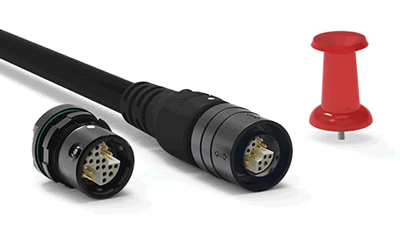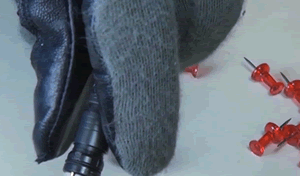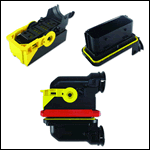When is a Small Connector Too Small?
Connector companies are meeting SWaP challenges as we move to mobile and wearable devices, but is there a time or a function when tiny is too small?

Fischer Connectors’ Mini Max
Electrical connectors just keep getting smaller as companies push size and weight out of their devices. Connector companies have risen to meet the SWaP (size, weight, and power) challenges driven by military organizations and throughout the industry as we move to mobile and wearable devices, but is there a time or a function when tiny is too small? Absolutely. Nano and micro connectors are appropriate when you have small amounts of data, extreme low-voltage power needs, or you rarely connect or disconnect the connector pair. But there’s no clear line when a connector becomes too small for a designer, so look closely at your application for user requirements to guide you.
Ease of Use
The main considerations for ease of use are:
- Frequency of connect/disconnect
- Use with or without gloves
- How tough or fragile the connector is
Ease of use needs to be examined in light of the number of times a connector will be mated and unmated in a given time. Usability isn’t quite as critical if you mate/unmate a connector only a few times a year. But if the device is mated and unmated every day, or multiple times a day, the simple mechanics of struggling to get a tiny connector into place can build resentment and ultimately impact the user’s satisfaction and ability to do the job efficiently. Eventually it will harm the brand’s reputation.
 We encourage our original equipment manufacturers (OEMs) to take a close look at where and how the end user will be working before recommending a specific connector, especially if they are in a medical, military, or scientific setting. If they are working with gloves, it almost always means a small-but-not-micro connector. If you get anything smaller than the diameter of a push-pin or a pencil, you risk someone being unable to put on or take off gear fast enough. Even in medicine, with smaller, disposable gloves, you need to make sure the connector can be handled properly, and that means paying attention to the human factor, i.e. size, finger grips, pressure needed to connect/disconnect, etc.
We encourage our original equipment manufacturers (OEMs) to take a close look at where and how the end user will be working before recommending a specific connector, especially if they are in a medical, military, or scientific setting. If they are working with gloves, it almost always means a small-but-not-micro connector. If you get anything smaller than the diameter of a push-pin or a pencil, you risk someone being unable to put on or take off gear fast enough. Even in medicine, with smaller, disposable gloves, you need to make sure the connector can be handled properly, and that means paying attention to the human factor, i.e. size, finger grips, pressure needed to connect/disconnect, etc.
In addition, the smaller and lighter a connector gets, the more likely it is to become fragile. We’ve all broken those fragile plastic clips on LAN cable connectors, and it only gets worse when the connector is smaller. If you are designing for anyone who might have a tendency to want to force the connector into place, it probably isn’t the place to go nano and fragile.
Connector Functionality
Considerations for connector functionality include:
- EMI shielding
- Level of sealing required
- Volume of data to transfer/speed of transfer
- Power requirements
Functionality considerations are significant when it comes to determining how small a connector you can get away with and still have a reliable device. Some miniature connectors don’t offer metal housings and can be easily disrupted by the RFI caused by another device. It’s also difficult to obtain IP68 or hermetic sealing in the smallest connectors.
Data transfer requirements and power are two important considerations that make you look at pin size and pin count. Smaller pins can’t run as much data as fast as larger pins and if the pin size is too small, you won’t be able to transfer power without risking a compromise in performance and premature failure in your connector.
Manufacturing
Considerations for manufacturing include:
- Pre-terminated connectors that limit options
- Pitch between contacts
- Connector versus cable diameter
If you work for a company that likes to keep options open on cabling, remember that some of the smallest connectors are only available pre-cabled. They are difficult to terminate, which limits your molding and sealing options. The pitch between contacts can be so small that it prohibits termination and/or the addition of insulating sleeving. A note to those who spec cable: We’ve seen people spec cable with the right wiring specifications, but the cable turned out to have a bigger diameter than the connector itself. Be careful not to choose a connector that is so small that it won’t work properly with the cable you want to run.
Final Thoughts
Almost everyone loves tiny connectors when they are used properly. Sometimes it is better to have one small, dense hybrid connector than two or three nano connectors. One connector designed for power and signal may take up less space, especially if you have to make room for gripping the connectors. There are some good choices on the market today, especially if you have multiple needs for your small device in a rugged environment.
[hr]
Author David Cianciolo is director of engineering at Fischer Connectors Inc.






